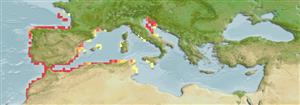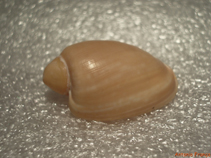Cymbium olla Linnaeus, 1758
Algarve volute| Native range | All suitable habitat | Point map | Year 2050 |

|
| This map was computer-generated and has not yet been reviewed. |
| Cymbium olla AquaMaps Data sources: GBIF OBIS |
Classification / Names Common names | Synonyms | CoL | ITIS | WoRMS
Gastropoda | Neogastropoda | Volutidae
Environment: milieu / climate zone / depth range / distribution range Ecology
Benthic; depth range 20 - 30 m (Ref. 106216). Temperate; 50°N - 30°N, 11°W - 18°E
Distribution Countries | FAO areas | Ecosystems | Occurrences | Introductions
Eastern Atlantic and the Mediterranean: Portugal, Strait of Gibraltar, Mediterranean in Andalucia, Alboran Sea to Malta, to the deep waters of the North African coast.
Length at first maturity / Size / Weight / Age
Maturity: Lm ? range ? - ? cm Max length : 15.0 cm SHL male/unsexed; (Ref. 109255)
Maximum length can grow more than 15 cm (Ref. 109255). Found in shallow and protected areas of up to 10 m deep in an estuary (Ref. 122253). Occurs in soft bottoms (Ref. 96488), in fine sands (Ref. 122262). Also found on Zostera marina beds (Ref. 96488).
Life cycle and mating behavior Maturity | Reproduction | Spawning | Eggs | Fecundity | Larvae
This species is a non-broadcast spawner. Life cycle does not include trocophore stage. Also Ref. 833.
Main reference
References | Coordinator | Collaborators
Gaspar, M.B., M.D. Dias, A. Campos, C.C. Monteiro, M.N. Santos, A. Chicharo and L. Chicharo. 2001. (Ref. 2714)
IUCN Red List Status (Ref. 130435)
CITES status (Ref. 108899)
Not Evaluated
CMS (Ref. 116361)
Not Evaluated
Threat to humans
Harmless
Human uses
Fisheries: commercial
| FishSource |
Tools
More information
Age/Size
Growth
Length-weight
Length-length
Morphology
Larvae
Abundance
Growth
Length-weight
Length-length
Morphology
Larvae
Abundance
Internet sources
BHL | BOLD Systems | CISTI | DiscoverLife | FAO(Publication : search) | Fishipedia | GenBank (genome, nucleotide) | GloBI | Gomexsi | Google Books | Google Scholar | Google | PubMed | Tree of Life | Wikipedia (Go, Search) | Zoological Record
Estimates based on models
Preferred temperature
(Ref. 115969): 14 - 18.4, mean 16.3 (based on 10 cells).



